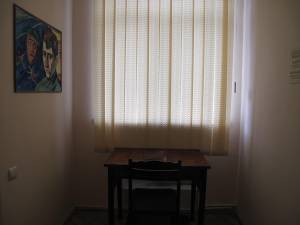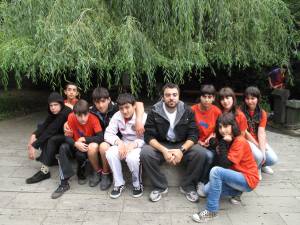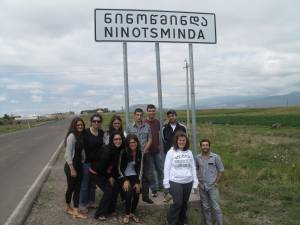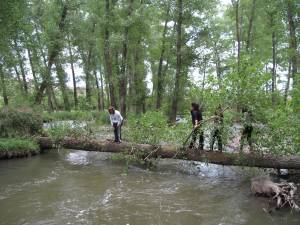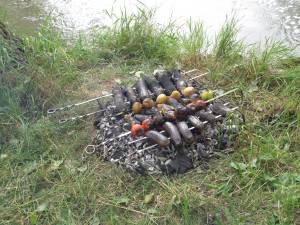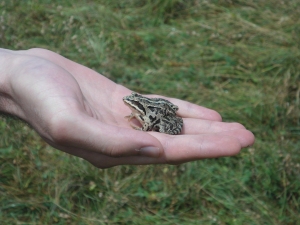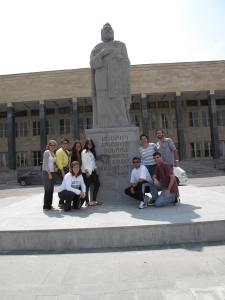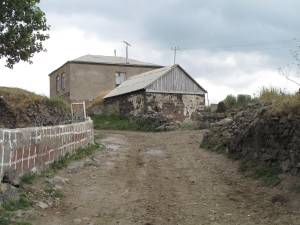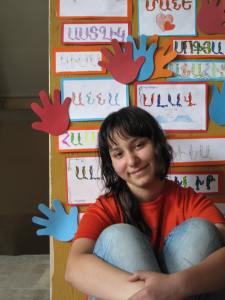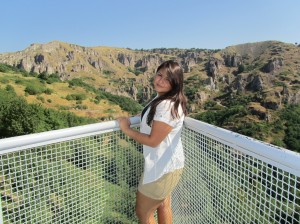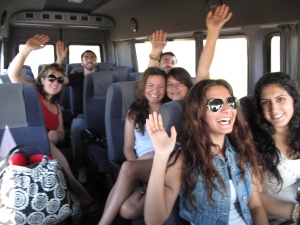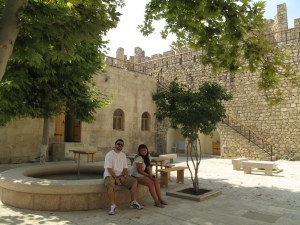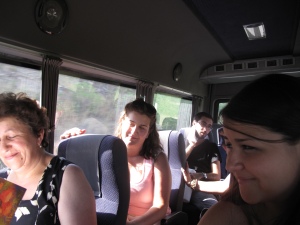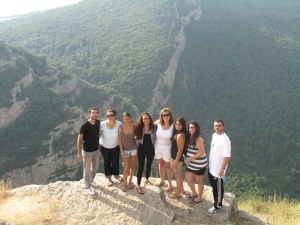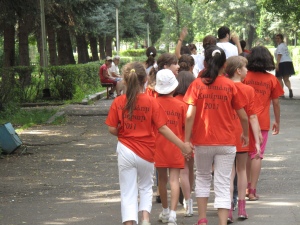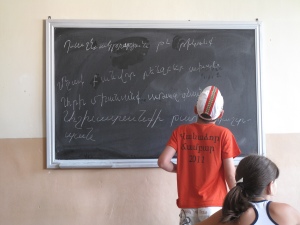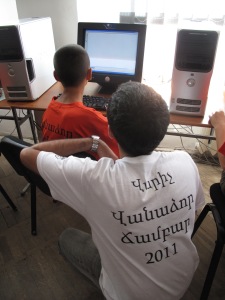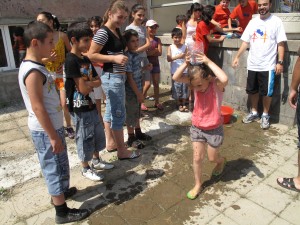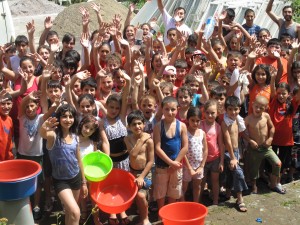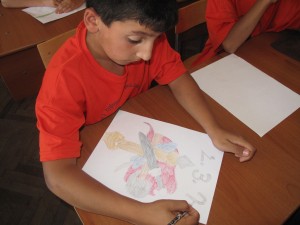Last Friday was the last day of AYF Camp Vanatsor. The two-week camp ended with a closing ceremony in front of the campers’ parents. They sang the songs they had learned as well as received school bags filled with notebooks, pencils and other material for the coming school year. In addition, every camper received a yerkaran (song book) published by the ARF Junior Organization of Armenia. Over twenty campers signed up for badanegan, to continue the fun activities all year long.
After an emotional parting, the group returned to Yerevan in time for the opening ceremonies of the 5th Pan-Armenian Games. One of the counsellors played soccer for the Montreal team, while the rest cheered him on. After a week of meeting new friends from Armenia and all around the world, we are packing once more for our return flight to Canada which takes off in a few hours.
What did you think about the camp? Send us your comments, whether it’s on the blog, on Facebook (AYF Canada), or on Twitter (@AYFCanada). Also, subscribe to our YouTube channel (http://www.youtube.com/user/AYFCanada) to be the first to see videos from the camp. Would you be interested in taking part in the AYF Youth Corps program? Do you want more information on volunteering in Armenia? We want to know!
AYF members know Stepan Zoryan as one of the three founders of the ARF. Better known as “Rosdom”, among other duties, he was the editor of the Droshak newspaper in Geneva.
There is, however, another Stepan Zoryan as well. Born in Karakilisa (today called Vanatsor) in 1889, this Stepan Zoryan also saw the establishment of the Democratic Republic of Armenia and then its Sovietization. He was also a writer, authoring many novels. Zoryan gained wide acclaim within the Soviet Union and his works entered into the Armenian school curriculum. After his death, his original home in Vanatsor was turned into a house-museum.
The eldest group at AYF Camp Vanatsor, the 13-14 year-olds, went on an excursion to the Stepan Zoryan house-museum. They learned about the writer’s life and his roots in their own city. It was encouraging for the young adults to learn about one of their own. Perhaps, one of them may be Vanatsor’s next great author.
Javakhk is a region that includes three main cities: Ninotsminda, Akhalkalak, and Akhaltskha. Although it is populated mostly by Armenians, Armenian newspapers are banned, teaching Armenian is strictly regulated, and Armenian priests are barred from some Armenian churches. The reason is that Javakhk is a part of Georgia, Armenia’s neighbour to the north, which views the Armenians’ presence there as an inconvenience. A program to settle ethnic Georgians in the area, as well as encourage the local Armenian population to emigrate is reminiscent of Soviet Azeri practices in Nakhichevan and Artsakh. The AYF Youth Corps councillors spent two days in Javakhk, experiencing the region’s history and culture. They saw the house museum of Vahan Teryan, the Akhalkalak Fortress, Lake Parvana, and Lake Saghamo, working in some time for a barbecue in the forest. It was truly an eye-opening experience to this rarely-visited part of the world.
(The two-week camp is actually finished already, but we have a backlog of blog posts…)
Monday morning had arrived and the campers were separated into three groups; red, blue and apricot. The red group were the 8 to 10 year olds, the blue were the 11 to 12 and the apricot, from 13 to 14. Our days started with the three groups singing “Mer Hayrenik” in front of our “Yerakuyn”. It followed by a visit to the local park for our daily physical exercises, followed by our daily activities. The campers created arts and crafts, learned new songs, and even got used to using a computer. On Wednesday, under the scorching sun, we played water games. The organized portion of the water games only lasted about ten minutes before it was interrupted by an all-out water fight. Luckily, most of the campers had brought a change of clothes. Later that day, we went to St Grigor Narekatsi church with all the campers, where the local priest explained the significance of the Armenian Church and its history in Vanatsor.
One aspect that was particularly rewarding was the enthusiasm with which the children paid attention to the Armenian history lessons (Armenian history immediately before the Soviet period is not emphasized in the school curriculum). Teaching them was a joy because they all listened and learned the songs and were eager to learn more.
As soon as the troupe landed in Yerevan, we headed to Khor Virap and a beautiful view of Ararat welcomed us to our dear Motherland. Along the way, we stopped for a little wine tasting at Areni; we climbed the steps of Noravank, and we took the longest tramway in the world to visit the ancient monastery of Datev. To wrap up our first day, our tired travelers rested in a modest hotel in Sisian, where khorovadz (Armenian barbecue) was definitely on the menu. Our second day began with a visit of Khentsoresk, an old town of caves that the Armenian population would use for safety during battles. The road being quite bumpy, our driver, Frounz, had to change a flat tire in the blistering heat. Thank goodness Ung. Alek and Ung. Ararad were there to help. In no time, the bus was rolling again, and thus began our adventure in Artsakh. Our first stop was Yerevan Hyuranots (Hotel) where the troupe freshened up and headed straight to Gandzasar and Tigranakert, one of the 3 cities built in honour of King Tigran the Great. Along the way, we saw the fortress of Askeran and the newly built Artsakh Airport. The day ended with a quick walk on Stepanakert’s “wifi zone” hrabarag (public square). After a good night’s sleep, we visited the Stepanakert history museum and the local ARF building. The group stumbled upon a museum dedicated to all the lost souls of the NKR war. With teary eyes, we saw hundreds upon thousands of pictures of fallen martyrs, and we heard the stories of their heroism. We left the museum inspired, and we headed towards Pegor Ashod’s monument where we met up with his widow, Ungh. Nelly Ghulyan, and continued our discovery of Artsakh all the way to Shushi. Of course, our journey would not be completed without a few bumps along the road. Our trusty car took a turn for the worse, so the “oukhdavors” along with Ungh. Ghulyan had to hike up to Ghazanchetsots. Hearing the story of Shushi’s liberation from Pegor’s widow was a once in a lifetime opportunity that we will never forget. We returned to Stepanakert by “avtobous” and met up with our fellow AYF Youth Corps volunteers from the States camped in Artsakh. Sharing stories, exchanging advice, we returned to our hotel impatiently awaiting the start of our camp in Vanatsor. As we left Artsakh on Sunday morning, we were full of hope yet the feeling was unanimous that our hearts were staying at the Zohvadsneri Museum (Museum of Fallen Heroes), where we found so many of the faces who gave their lives to protect those of others.
Voghtchouyn!
Hope everyone back in Canada is doing well. Our group of 9 “oukhdavors” has comfortably settled in Vanatsor by now. Our jampar began on Monday morning; 50 kids showed up despite it being “Merelots”. They met us with smiles and curiosity as we explained the purpose of the jampar and let them in on what we’ve planned over the course of the next two weeks. On the first day, the counselors took time to learn more about the kids, get accustomed to terms and expressions to better understand the children… Since then, we’ve done arts and crafts, science experiments, learned “Mshag Panvor”, celebrated Vartavar and visited the local church with the group. As the days go by, word gets around about our initiative and it’s becoming very difficult to turn the newcomers away each morning as we’ve reached maximum capacity with 90 kids attending our camp daily.
Mingling with these kids is truly fulfilling. They are full of energy and have such interest for everything we present them. It is refreshing to see them walk through the doors of our camp each morning, proudly sporting their t-shirts and greeting us with a “barev unger – ungerouhi”.
I can’t wait to see how things will unravel over the course of the next two weeks… Stay tuned!
This year, Vartavar falls on July 31 in Armenia. The holiday couldn’t fall on a better day as it reportedly reached 40 C in Yerevan. Vanatsor is a bit cooler at 35 C. Vartavar dates from pre-Christian Armenia but has since been incorporated into the calendar of the Armenian Church. On this occasion, in the middle of the summer heat, Armenians cool off by drenching each other with water. Particularly children under 16 have the right to empty their bottles on you without repercussions. It doesn’t matter if you’re a stranger (or if you have your cell phone in your pocket), you need to be on your guard on Vartavar. Even if it seems like no one is around, beware of children with buckets on apartment balconies.
The best way to enjoy Vartavar is to look at it as a country-wide water fight. If you want to stay dry, take a taxi (and roll the windows up).
After a day-long layover in Warsaw, the Camp Vanatsor counsellors landed in Yerevan early this morning. They are already on the road with a full itinerary for the day. The first stop is Khor Virap, the site where St. Gregory the Illuminator was imprisoned before he became instrumental in converting Armenia into the first country to adopt Christianity as its state religion in 301 AD. From there, it is on to Noravank Monastery, the Areni Winery, and the Tatev Monastery, for which they will take the longest cable car in the world.
For Alek Ohanian and Ararad Torosyan, this trip is especially meaningful. It will be the first time that they behold majestic Mount Ararat through their own eyes.
Vanatsor is Armenia’s third-largest city. It was the site of the Battle of Karakilisa in 1918, when the outnumbered Armenian defenders turned back the Ottoman Army which was seeking to eliminate the last bastions of Armenian settlement on the heels of the Armenian Genocide.
The city was also affected by the 1988 Spitak earthquake (magnitude 6.9) which claimed 25,000 lives.
Today, in 2011, 10 young volunteers from AYF Canada are putting on a two-week summer camp for the children of Vanatsor, many of whom will be from the nearby mankatun (orphanage) and other disadvantaged families. The volunteers hope to provide opportunities that the children do not normally have including computer lessons, English and French classes, arts and crafts, and educationals about health and citizenship. The day camp is free for the kids, who are also provided with a daily snack and lunch. School supplies are handed out as prizes.
The camp is also a treat for the volunteers, however. Of the 10 volunteers, 2 have never been to Armenia, the land of their ancestors. They will get a glimpse of daily life in an average Armenian city, as well as see many historic sites on side trips.
The summer camp approach to community service was pioneered by the AYF Western United States region, who since 2008, has been operating a similar camp in Gyumri, Armenia’s second-largest city. In 2011, a second site was opened in Stepanakert (See http://www.ayfyouthcorps.org/).
As the participants are about to board their flight, they hope you will check back often to see the camp’s progress.
Hajoghutiun!




